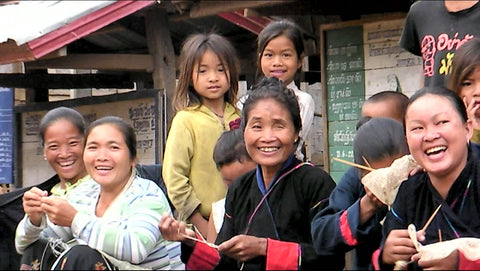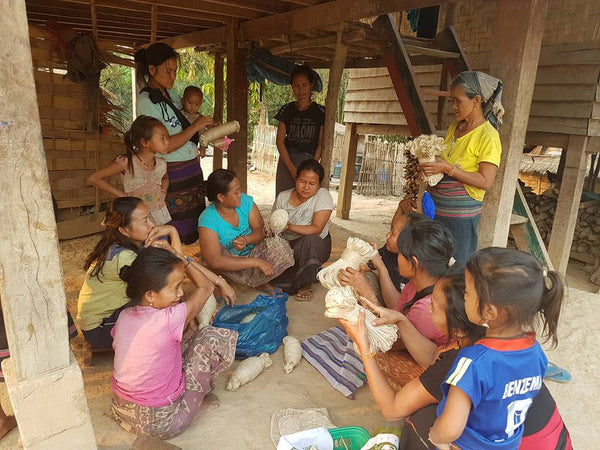The JungleVine Foundation's Nature Bag Project
The JungleVine Foundation’s mission is to connect remote isolated tribal communities with the global market by promoting their natural fiber handicrafts. Our work reduces poverty in rural Laos, preserves an ancient craft, and mitigates global climate change through the promotion of organic vegan JungleVine® fiber.

The JungleVine Foundation and our sister organization in Laos, the Lao JungleVine® Production Promotion Co. Ltd., work with indigenous Khmu artisans in Laos to promote, market, and sell their JungleVine® handicrafts all over the world. Our two organizations share a common mission; to connect these remote isolated tribal communities with the global marketplace. Our work reduces poverty in rural Laos, preserves an ancient craft, and mitigates global climate change through the promotion of JungleVine® fiber.
In the 19 years since the project's inception, we have worked with hundreds of artisans who have produced more than 60,000 pieces. Hand-made JungleVine® products are sold in approximately 400 boutiques in 28 countries and territories worldwide. The project continues to expand to additional Khmu villages as more of the world becomes aware of the products and demand grows.
Most often, the individual artisans tell us they spend their now cash income on rice, clothing, and school supplies for their children. The impact of Nature Bag income is readily visible when visiting Khmu villages. Settlements where there is not yet Nature Bag income generally have single-story homes with walls made of woven bamboo slats, thatch roofs, and bare ground floors. The villages whose artisans have worked with the project longest have 2-story homes, with concrete foundations, wood or concrete walls, ceramic tile floors and hardened low-maintenance roofs.
The artisans who create JungleVine® products have been able to improve not only the lives of their families but also are able to contribute to the well-being of others within their villages. In Khmu culture, for example, the entire village works together to support the elderly among them who have no family to care for them. When needed, they come together to build a home for a neighbor, and as a community, they make sure that everyone within the village has food to eat.
Our story begins in November 1972, when 25-year-old Iowan (agricultural heartland of USA), then living on West 66th Street New York City, Bill Newbrough, visited Laos. He traveled to the ancient royal capital, Luang Prabang. Nestled on a peninsula between the Mekong and Khan Rivers, Luang Prabang is a scenic village first settled in 698 CE. It is the home of many ornate Buddhist temples and was the seat of Royal power for more than 15 generations of Lao rulers. When Bill arrived, he was struck by the beauty of his surroundings and charmed by the kind and gentle Lao people.

Laos had been relentlessly bombed since 1964 during the American war in Vietnam, and in 1972 was in the final throes of a civil conflict between revolutionaries and American mercenaries supporting the Royal government. Luang Prabang was surrounded by the war when Bill arrived, and many of its people, including the Royal Family, had fled. Two days into his visit, the intelligence was that Pathet Lao rebels, who controlled virtually all Northern Laos, would be moving in to capture the ancient Royal capital. When he went to get onto a Royal Air Laos flight to begin the journey back to New York, he found all seats taken by the official Australian delegation, which was evacuating to Vientiane. Bill was unable to get out.
Trapped, he spent a night watching planes dropping aerial flares, the lights from tracer bullets tearing through the jungle, and hearing massive, earth-shaking explosions. The experience impacted him profoundly. When he was finally able to leave, he knew that he wanted to return to Laos when it was safe.
After the war ended, Bill returned to Laos many times. He brought the first mountain bicycle ever seen in Northern Laos and used it to travel the countryside. His guide on a cycling adventure in 2002 was a Lao student named Bonsou "Sou" Keoamphone. At the end of their travels together, Sou gave Bill a strange-looking bag as a souvenir. A minimalist, Bill had little use for souvenirs and would have left the bag behind in Laos had it not been so compact and lightweight.

Back in the U.S. months later, Bill set out to repair the roof of his home. Unable to fit all of his tools and supplies into a canvas grocery bag, he decided to use the bag Sou had given him. He immediately was impressed at how the bag stretched to hold so many bulky, sharp, heavy items. He feared that the project would destroy the fragile-appearing and seemingly delicate bag. But what mattered more was getting the roof repaired before the next rain. Bill was astonished that not only did the bag hold up, but it was far superior to the canvas bag in every way. It was rugged, stretchy and strong, and it gripped the shingles rather than slipping down the steep roof as the canvas bag did. It also held things inside without having a fastener to close it.
Thoroughly impressed by the bag's performance, Bill contacted Sou and told him these bags should be sold all over the world. Sou told him they are made by the Khmu, the original people in Northern Laos for their own use in gathering essentials in the mountainside jungles and were not available for sale because the Khmu at that time had no use for money--there was nothing available to spend it on. Bill returned to Laos, and the two set out to visit remote villages, buying bags when they found them, asking if the Khmu people would be interested in making the bags for the global marketplace.
The Nature Bag was traditionally used to carry a day’s harvest. The design has been passed down for millennia, but plastic material from bags used to import goods nearly decimated the craft by offering the Khmu a quickly converted alternative. Bill was amazed to learn that the bags are made using fiber from a perennial vine (Pueraria phaseoloides), now universally known as JungleVine®, that grows without any agricultural input. The fiber is 100% sustainable and genuinely eco-friendly with a negative carbon footprint. To the lifelong environmentalist and minimalist in Bill, this was incredible news. It meant that the bags were even more extraordinary than he’d first discovered.
Bill and Sou built relationships with Khmu tribes in remote villages all over northern Laos. They learned which Khmu clans retained the ancient bag-making skill and found hundreds of artisans eager to create bags initially trading for goods from the outside that the Khmu could use. The Khmu artisans enjoy working from home while nurturing their children and preserving their traditional culture. Most Khmu villages are so isolated that there were no other opportunities to get clothing, blankets and other useful items or to earn cash income. At last, Bill was able to realize his dream of helping the people of Laos.
JungleVine® supplies the base material for Khmu artisans to create Nature Bags, the most eco-friendly bags on Earth. It is a product that can provide an entire iron-age culture with a sustainable livelihood in the modern world. When you buy their hand-made eco-friendly JungleVine® products you directly support the Khmu artisans and indirectly support their entire villages.


The JungleVine® Foundation is designated a public charity under section IRC 501(c)(3) of the Internal Revenue Service code. Contributions, bequests, devices, transfers, and gifts are tax-deductible and can be made online or by mail at 3319 3rd St, Suite 2, Des Moines IA 50313, USA.

Meet Our Team
Meet the Khmu Artisans who create JungleVine® products
Learn more about Nature Bag's History and Origins
Watch Nature Bag Videos
Learn about the JungleVine® Research Retreat
Find additional stories and news in our Blog and on Our Wall
Discover more about the Khmu culture at Professor Damrong Tayanin's website.
Did you know that U.S. President Barack Obama visited Laos in 2016, and was the first U.S. President in history to do so? We've got some fascinating inside coverage of his visit here: Obama's Visit to Luang Prabang
Learn about other organizations making a difference in Laos.
If you are fascinated with Laos and Khmu culture like we are, check out Somsy Camvan's captivating historical fiction novels The American Ghost, Other Side of Mekong, and Blanket Coffin.

